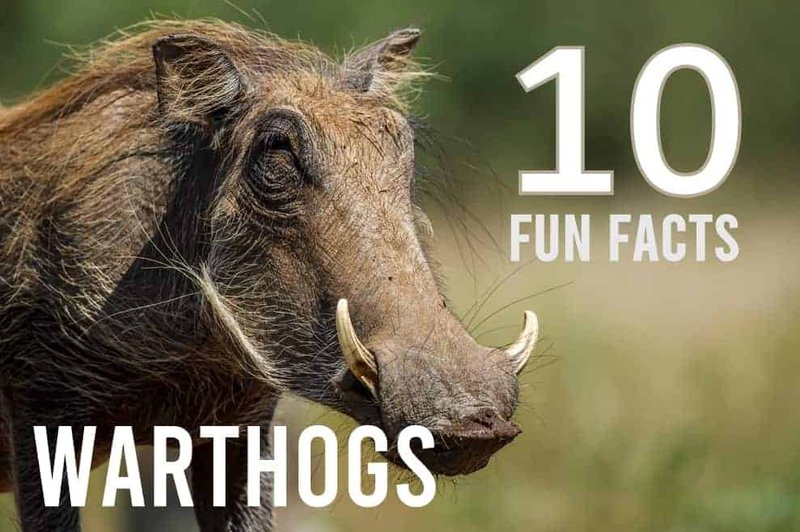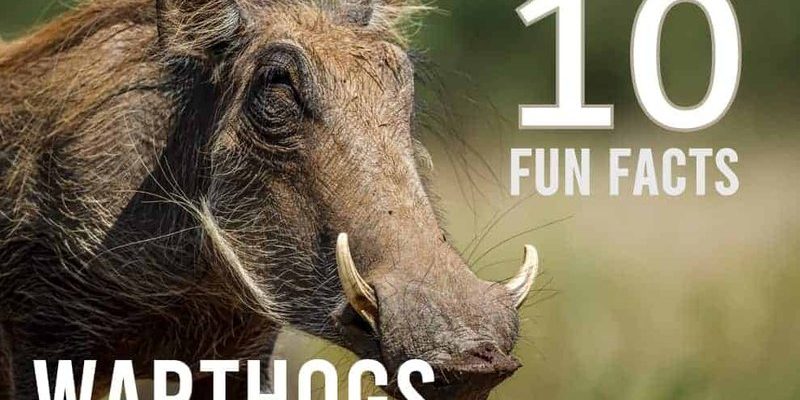
Warthogs are fascinating not just because of how they look, but also due to their behavior and adaptations. They play an essential role in their ecosystem, and if you’ve ever seen one, you know they can be both silly and charming. Let’s dive into ten captivating facts about these remarkable creatures that will surely pique your curiosity.
1. Unmistakable Appearance
The first thing that comes to mind when you see a warthog is its unique look. With a stocky body, short legs, and a long face, they definitely stand out. But what’s really intriguing are their tusks. Warthogs possess two sets of tusks: the upper ones are long and curved, while the lower ones are shorter and used more for digging and defense.
These tusks play a critical role in their survival. When threatened, warthogs can use them to defend themselves against predators, and when foraging for food, they dig through the earth with their snouts, exposing roots, tubers, and other tasty snacks to munch on. Honestly, their impressive tusks add a touch of character, making them a favorite among wildlife enthusiasts.
2. A Unique Defense Mechanism
Here’s the thing with warthogs: they have a rather unusual way of protecting themselves. While many animals will run when danger approaches, warthogs often do the opposite. They’ll dig into the ground, curling up inside abandoned burrows or hiding in thick grass. This clever behavior helps them stay hidden from predators like lions and hyenas.
You might be wondering what happens when they’re cornered. Warthogs can quickly charge at a predator, using their tusks as weapons. Imagine a small tank on legs! Their surprising ability to turn the tables can leave many would-be attackers taking a step back. Their instincts keep them safe, showcasing how adaptable and resourceful these animals can be.
3. Social Creatures
Warthogs might seem solitary at first, but they’re actually social animals that enjoy the company of their family groups. Typically, you’ll find them in small groups, often consisting of a few females and their young. Male warthogs tend to be more solitary, especially as they grow older.
This social structure is important for the survival of the group. The females help look after each other’s piglets, teaching them essential survival skills. For instance, they show them where to find food and how to stay alert for predators. By working together, the warthogs increase their chances of survival in the wild, leaning on the strength of community.
4. Fascinating Feeding Habits
Warthogs are primarily herbivores, which means they munch on a variety of plants, including grasses, roots, and fruits. Their diet reflects their adaptability; they can thrive in different environments, from savannahs to woodlands. But what’s even more interesting is how they eat.
They often feed on their knees, which looks quite funny. Imagine a little piggy learning a new dance move! This feeding posture allows them to reach grass and roots without straining their backs. In times of drought, they’ll use their tusks to dig deeper into the ground, showcasing their remarkable ability to find food even when the situation gets tough.
5. Communication Style
Warthogs have their own way of chatting! They communicate using a variety of sounds, which can range from grunts and snorts to squeals and barks. Each noise has its meaning, whether it’s to alert others about danger or simply to greet one another.
Their communication is vital for maintaining social bonds within the family group. For example, a mother warthog will grunt softly to keep track of her piglets, especially when they stray too far while foraging. This social soundscape creates a sense of community, allowing them to stay connected even when roaming in open spaces.
6. Their Natural Habitat
Warthogs play a significant role in their ecosystem, primarily found in sub-Saharan Africa. They thrive in savannahs and grasslands, which provide plenty of food and hiding spots from predators. But you might not realize how important they are to their habitat.
When warthogs dig in the ground for food, they create holes that other animals can use. This behavior helps aerate the soil and promotes plant growth in the area, contributing to a healthy ecosystem. They essentially create a buffet table for other creatures, enhancing biodiversity. So, while they may seem like simple foragers, their actions support life around them.
7. Breeding and Lifespan
When warthogs reach maturity, they’re ready to breed, typically around two to three years old. The female warthog has a gestation period of about 5 to 6 months and usually gives birth to a litter of two to five piglets. These little ones are born somewhat precocial, which means they’re relatively developed and can move around quite quickly after birth.
In the wild, warthogs can live up to 15 years, though many face threats from predators that can shorten their lifespan. Interestingly, those in protected environments, such as wildlife reserves, often live longer due to reduced threats. Their life cycle is a captivating reflection of survival and adaptability in the wild.
8. Cultural Significance
In many African cultures, warthogs hold a unique place in folklore and storytelling. They often symbolize determination and resilience, qualities that many admire. Additionally, their quirky appearance has made them popular in various art forms, from sculptures to paintings.
For instance, in the famous Disney movie “The Lion King,” the character Pumbaa, a lovable warthog, showcases their personality in a fun and entertaining way. This representation has helped bring awareness to the species, encouraging interest in wildlife conservation. Warthogs aren’t just animals; they are part of the cultural fabric that connects people to nature.
9. Conservation Status
Warthogs are generally considered to be of least concern regarding extinction risk. However, their populations can be affected by habitat loss due to agriculture and human encroachment. As urban areas expand, these charming creatures face challenges in finding suitable habitats.
Conservation efforts are underway in several regions to protect their habitats and ensure their survival. Proper management of land and resources is crucial, not only for warthogs but for the entire ecosystem they inhabit. By staying informed and supporting conservation initiatives, we can help ensure these remarkable animals continue to thrive for generations to come.
10. Warthogs in Popular Culture
Finally, beyond their role in ecosystems, warthogs have made their mark on popular culture. They often appear in documentaries, children’s books, and even toys. Many people are drawn to their quirky appearance and spirited nature, making them relatable characters in media.
This interest fosters a greater appreciation for wildlife and the importance of preserving natural habitats. Warthogs provide a gateway for people to learn about the complexities of nature, encouraging conversations about conservation and biodiversity. By loving the quirky features of these animals, we can spark curiosity and advocacy for wildlife protection.
Warthogs might not have the glamour of lions or giraffes, but they certainly have their own charm. With these ten fascinating facts, you can appreciate them a little more as you explore the beauty of the African savannah. So, next time you hear someone mention a warthog, you can share some intriguing tidbits that showcase their unique role in nature. Through understanding and appreciation, we can all contribute to the preservation of these incredible creatures.

